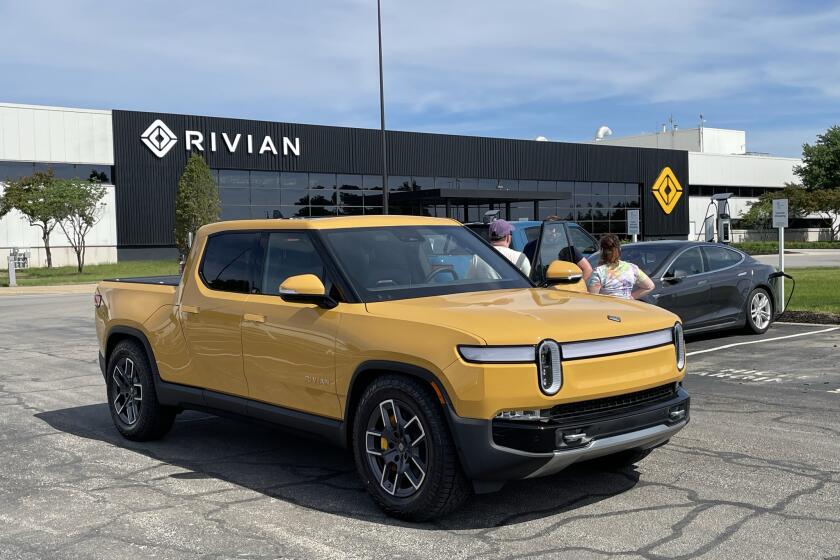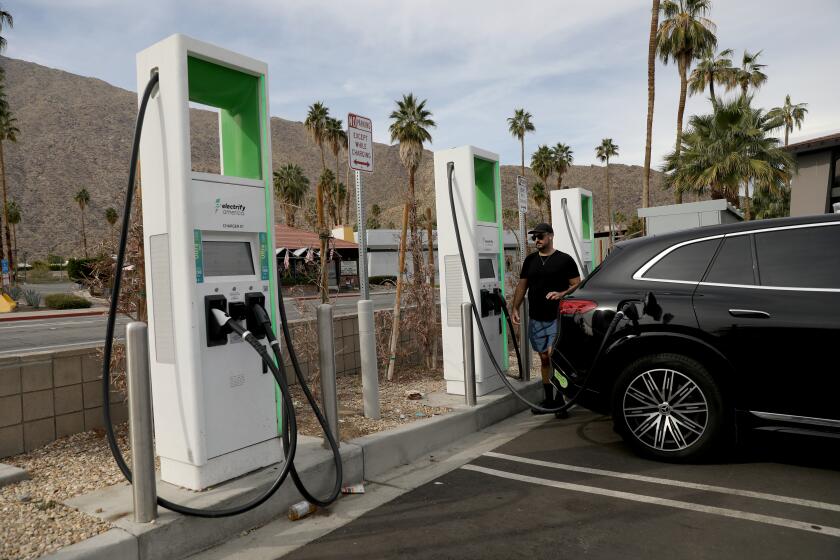“Design is a feeling--something right in my fingertips that has to be released.” : Time Finally Catches Up With Designer’s Car of the Future
It can be difficult to get Cliff Hall to sit still for more than a few minutes at a time when his fertile imagination is throwing off ideas. He grabs any piece of paper within reach--a napkin, the back of a photo, margins of newspapers--and begins sketching a proposed answer to his many questions that begin: “What if. . . ?”
His “what ifs” have led, among other things, to a compact set of furniture--table, sound system, closet and bed--that all folds into a cabinet measuring 6 by 4 by 2 feet, a mobile film processing lab and an on-board system to alert drivers of approaching emergency vehicles--a safety device intended for motorists who are hard of hearing or simply love loud music.
Sadly, Hall has never found the financing to bring any of those products to market.
His most challenging “what if” came back in 1965, when he arrived at the perfectly sensible conclusion that one effective way to improve economic and social conditions in black communities would be to develop some industries.
He decided to build a car.
And what a car he built: With a $100,000 stake from the late Beverly Hills businessman Louis Corwin, Hall built a prototype--a stunning two-seater with a fiberglass body still regarded as 20 years ahead of its time. When the car, named the Corwin, was completed in 1969, its projected price was about $4,500.
Hall said Corwin, an importer of Panasonic electronics products, told him: “I had no idea your car would be this sophisticated. I guess you’re on your way.”
“I told him,” Hall said, “I was going to be the Martin Luther King Jr. of industry.”
*
All angles and elbows, Hall, who will be 69 on Thursday, has a rail-thin, Ichabod Crane physique and enough energy to leave people half his age panting trying to keep up with him. He is the world’s greatest endorsement for junk food. His mornings typically begin with coffee and jelly doughnuts. He has never met a greasy hamburger he didn’t like, and he is a connoisseur of carryout from fast-food joints in his Mid-Wilshire neighborhood. Eating is just an inconvenient interruption of his planning, sketching, designing.
“What motivates me more than anything else is that I like to create,” he said. “I like to take raw material and turn it into something of value. Design is a feeling--something right in my fingertips that has to be released.”
A Los Angeles native, Hall was chief photographer for the Los Angeles Sentinel, the African American weekly newspaper, for 27 years. He nurtured young talent such as Howard Bingham, who went on to shoot for Life magazine and became Muhammad Ali’s official photographer.
Hall was also a much-in-demand society photographer in Beverly Hills and Bel-Air for nearly a decade, beginning in the 1950s, and ran a photo studio on Western Avenue and 48th Street that has passed into South-Central Los Angeles legend. One photographer there was Lamont McLemore, one of five singers who formed the 5th Dimension in Hall’s studio.
None of Hall’s friends doubted that he could build a car. After all, they had seen him build a sophisticated miniature electric car in the late 1950s for his grade-school-age son, a car the boy drove into a neighborhood drive-in restaurant where a car hop served him a hamburger.
Hall comes from a long line of tinkerers. “My grandfather was a watchmaker and my grandmother’s two brothers built race cars and an airplane for themselves back in the 1920s.”
When Hall completed the Corwin, he began scouring the black community for financing to build production molds. For the last 25 years, Hall said, he has “gone to politicians and supposedly black investment people and . . gotten little or no help--not even encouragement.” His voice trailed off in frustration. “For them not to see the value. . . .”
Hall said even his friends were pessimistic, telling him: “The Man ain’t gonna let no brother build no cars.”
Hall’s answer: “The Man gave me the money to build the prototype because he thought it was admirable that I wanted to do something on this magnitude in our community.”
*
The Corwin languished in storage until Los Angeles County’s new Petersen Automotive Museum on Wilshire Boulevard and Fairfax Avenue got wind of it.
“This car did predate the Pontiac Fiero and the Fiat X 1/9, two small, popular mid-engine cars (with engines between the axles) that gained international reputations,” said Leslie Kendall, the manager of the museum’s automobile collection. “Visitors like its compactness, plus they think it’s an attractive car.”
If the times are catching up to Hall’s idea, he and his partner, designer Dennis Huguley are ready with another project. They have come up with a bullet-shaped, enclosed, two-passenger, three-wheel motorcycle that can be powered electrically or with gasoline.
“The passenger compartment will have the feel of a motorcycle, but it will have the safety of two rear wheels to give it stability,” Hall said. “It will have air conditioning, a heater, a CD player, a radio and a removable canopy.”
Again, none of Hall’s friends doubt that he and Huguley can build their “Magic Machine,” as they call it. But Hall is finding that raising capital to build a prototype is every bit as tough in 1994 as it was in 1965.
Larry Reynolds, a photographer at the Petersen Museum, was admiring Hall’s car recently, recalling how he had seen the Corwin at the 1970 Los Angeles Auto Show.
“This car should have been built,” Reynolds said. “He worked damned hard on it. The problem was that it probably wasn’t the ‘in’ thing to do at the time. Now it would probably happen.”
Hall is hoping that it will happen with the Magic Machine.



